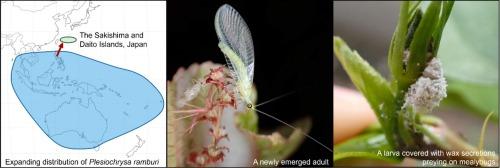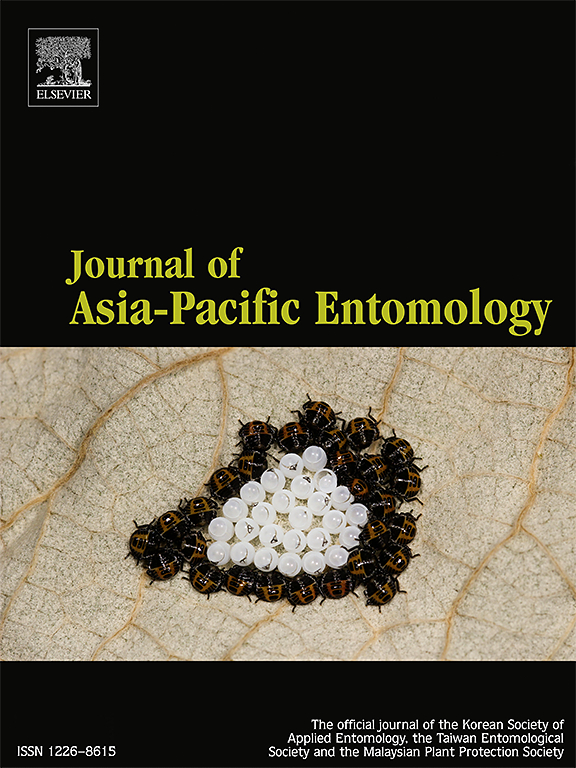在日本咲岛群岛,野蛾(神经翅目:野蛾科)的建立和捕食入侵粉蚧的野外证据
IF 1.3
3区 农林科学
Q3 ENTOMOLOGY
引用次数: 0
摘要
入侵性害虫的传播在世界范围内造成了巨大的农业损失。它们的天敌也可以扩大它们的分布,从而为生物防治提供了潜在的机会。绿草草Plesiochrysa ramburi (Schneider)广泛分布于东南亚至澳大利亚、波利尼西亚和密克罗尼西亚,因其捕食具有重要经济意义的粉蚧而成为农业害虫防治的潜在天敌。近年来,日本只记录了少数标本,该地区物种的生态特征仍然知之甚少。在日本的Sakishima群岛,我们记录了与入侵害虫粉蚧相关的P. ramburi的多个成虫和未成熟虫的卵、幼虫和蛹。从石垣岛多个地点收集草蛉,并在100多公里外的宫古岛观察草蛉,证实在该地区广泛存在。未成熟阶段与三种入侵粉蚧的菌落密切相关,即边缘副球菌、扶桑绵粉球菌和毛毛单胞球菌。观察到被其猎物分泌的蜡状分泌物覆盖的兰布氏夜蛾幼虫捕食粉蚧。我们讨论了在日本继续扩大其分布的潜力及其作为害虫控制天敌的潜力。本文章由计算机程序翻译,如有差异,请以英文原文为准。

Field evidence of Plesiochrysa ramburi (Neuroptera: Chrysopidae) establishment and predation on invasive mealybugs in the Sakishima Islands, Japan
Spreading invasive pest insects cause substantial agricultural damage worldwide. Their natural enemies can also expand their distributions, thus presenting potential opportunities for biological control. The green lacewing Plesiochrysa ramburi (Schneider), widely distributed from Southeast Asia to Australia, Polynesia, and Micronesia, has potential as a natural enemy for agricultural pest control owing to its predation on economically important pest mealybugs. Only a few specimens have been recorded in Japan in recent years, and the species’ ecological characteristics in the region remain poorly understood. Here, we recorded multiple adults and immatures—eggs, larvae, and pupae—of P. ramburi associated with invasive pest mealybugs in the Sakishima Islands, Japan. Collection of the lacewings from multiple sites on Ishigaki Island and their observation on Miyako Island, over 100 km away, confirms widespread establishment in the region. Immature stages were closely associated with colonies of three invasive mealybug species, Paracoccus marginatus, Phenacoccus solenopsis, and Maconellicoccus hirsutus. Larvae of P. ramburi, covered with wax secretions from their prey, were observed preying on the mealybugs. We discuss the potential for P. ramburi to continue expanding its distribution and its potential as a natural enemy for pest control in Japan.
求助全文
通过发布文献求助,成功后即可免费获取论文全文。
去求助
来源期刊

Journal of Asia-pacific Entomology
Agricultural and Biological Sciences-Insect Science
CiteScore
2.70
自引率
6.70%
发文量
152
审稿时长
69 days
期刊介绍:
The journal publishes original research papers, review articles and short communications in the basic and applied area concerning insects, mites or other arthropods and nematodes of economic importance in agriculture, forestry, industry, human and animal health, and natural resource and environment management, and is the official journal of the Korean Society of Applied Entomology and the Taiwan Entomological Society.
 求助内容:
求助内容: 应助结果提醒方式:
应助结果提醒方式:


